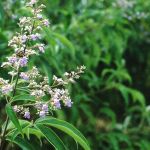| Common Name: |
Chinese Chaste Tree |
| Botanical Name: |
Vitex negundo |
| Genus: |
Vitex |
| Family: |
Verbenaceae |
| Native Location: |
E Africa, E Asia |
| Cultivation: |
Well-drained to poor dry soil in sun. Cut back the previous year's growth to 2.5-5cm (1-2in) in spring. Tolerates hard pruning. |
| Propagation: |
By seed sown when ripe or in spring; by semi-ripe cuttings in summer. |
| Harvest: |
Leaves are picked in early summer, and used fresh as juice, or in infusions and poultices, or dried for use in decoctions. Stems are cut in late summer or autumn and dried for use in decoctions and charcoal powder. Roots are lifted in late summer or autumn, and dried for use in decoctions. Fruits are collected in autumn, and used fresh or dried in decoctions or powder. Oil is extracted mainly from V. negundo var. cannabifolia. |
| Height: |
3-5m (10-15ft) |
| Width: |
3-5m (10-15ft) |
| Variations: |
cannabifolia
Has leaves resembling those of Cannabis sativa (See, Marijuana). |
heterophylla
(cut-leafed/hemp-leafed chaste tree)
Has a more northern distribution, and leaflets with deeply toothed margins, which in some plants are almost divided into segments. |
|
| Hardiness: |
Z6-10 |
| Parts Used: |
Leaves, stems, roots, fruits (huang jing zi), oil. |
| Properties: |
A sedative, cooling, detoxifying herb that lowers fever, relieves pain, improves digestion, and is expectorant and anti-bacterial. |
| Medicinal Uses: |
Internally for poisonous bites, malaria, arthritis, and breast cancer. Externally for ringworm (leaves), rheumatic and arthritic pain, toothache, and sore throat (stems), colds and coughs (all parts); asthma and digestive disturbances (leaves, roots, fruits), bronchitis (roots, fruits, oil), hemorrhoids, migraine, and eye problems (fruits). In Ayurvedic medicine, internally for headache, mucus, and gonorrhea (leaves), fevers and bronchial congestion (roots); externally for ulcers (juice of leaves), and sores (medicated oil). |
| Economic Uses: |
Fresh leaves are burned with grass as a fumigant for mosquitoes. |
| Warning: |
Not given to patients with heart disease or hypertension. |
| Bibliography: |
The Encyclopedia of Herbs by Deni Bown Copyright © 1995, 2005. Dorling Kindersley Limited. pp 406-407. |
